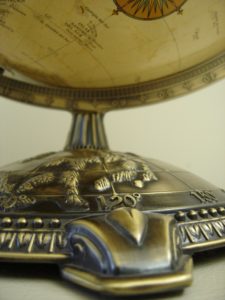
His grandmother’s old Replogle rests by the window.
Spinning it around, he finds the pink lip of Chile cracked
and a crease, east of the Hawaiian Islands, cresting
at 500 nautical miles, according to the legend.
In the northeast, the Union of Soviet Socialist Republics sprawls
at about the size of his hand from palm to fingertip,
and Italy’s little inch feels as rough to him as a scab.
He rubs his finger gently across New England and turns
up nothing but dust. Glancing outside, he
almost expects to find some giant finger wiping away
the pollen and the scattered bits of catkin, but
he finds only the heaving threat of rain in the sky.
Today he turns 30; by next week his grandmother would’ve
already been 89. According to the Times,
LeRoy M. Tolman, the cartographer who designed
this globe, died on September 12, 2015. He was 84.
The photograph of him at the top of the obit —
autographing a globe, half grinning with that tired
satisfaction of one who understands the world —
was taken in May 1987, the month he was born.
And so what? Why should he make some tired observation
on the indifference of nature, or the Heraclitian
worldview of the eternal flux, or the globe’s inability
to capture the receding shorelines, the melting glaciers,
and the oscillations of nations and borders —
the inability of things to just stay put?
But what other lesson can he learn today?
He looks into this 12-inch globe, like a mirror
he’s been looking at his entire life, for as long
as he can remember, and barely recognizes himself.
He thinks about how, after his grandmother died,
his grandfather, perhaps instead of crying, would
repeat her name, over and over, in a mantric-like whisper,
as though trying to be grounded in it,
clung to it like gravity clinging to the Earth.
About the Author:
Christopher Kobylinsky is an adjunct professor at Holyoke Community College in Massachusetts where he teaches English composition and literature.
